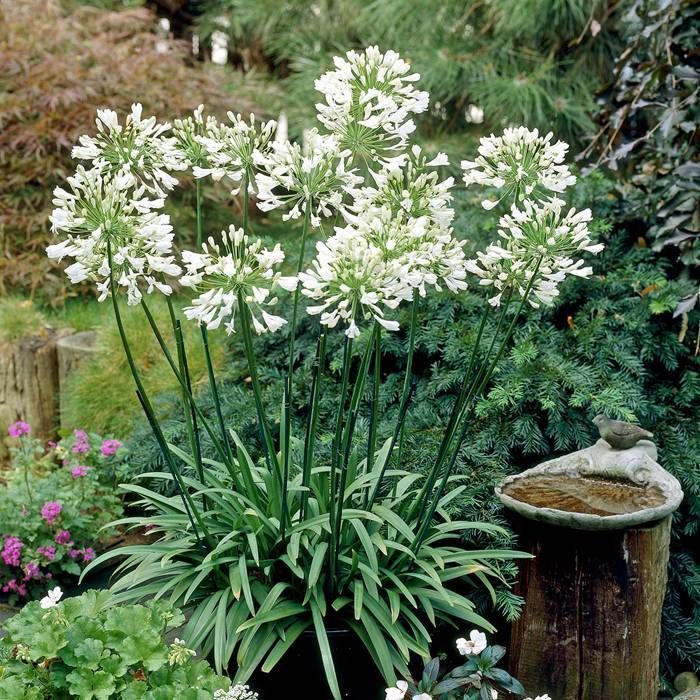Seasonal Agapanthus Treatment: Getting Ready For Winter Season and Summer
Seasonal Agapanthus Treatment: Getting Ready For Winter Season and Summer
Blog Article
Unleashing the Secret to Effective Agapanthus Growing: Idea for a Flourishing Garden
In the realm of gardening, growing agapanthus successfully needs a tactical strategy that encompasses numerous aspects of plant care. By recognizing the nuances of agapanthus growing, one can develop an environment where these plants flourish and flower generously.
Growing Agapanthus: Best Practices
When planting Agapanthus, appropriate dirt prep work is essential for making sure effective development and development of these gorgeous flowers. Agapanthus, frequently referred to as Lily of the Nile or African lily, thrives in well-draining soil with a slightly acidic to neutral pH level - Agapanthus. Before planting, it is important to change hefty clay dirts with raw material such as compost or peat moss to improve water drainage and give essential nutrients for the plants
To plant Agapanthus, choose a location that receives complete sunlight to partial color, as this will advertise healthy and balanced development and abundant blooming. Dig a hole two times the diameter of the plant's root round and position the Agapanthus at the same deepness it was previously expanding. Delicately backfill the opening with soil, weighing down firmly to remove any type of air pockets around the roots.
Water the recently grown Agapanthus completely and proceed to keep the soil evenly damp, specifically throughout the plant's energetic expanding period. Agapanthus. Applying a balanced plant food once a month can additionally sustain the plant's growth and flowering. By adhering to these ideal methods for planting Agapanthus, you can create a sensational display screen of these fascinating flowers in your garden
Perfect Dirt Conditions for Agapanthus
For ideal growth and flowering success of Agapanthus plants, guaranteeing the soil problems are suitable is vital. Agapanthus prospers in well-draining soil with a slightly acidic to neutral pH level varying from 6.0 to 7.0. This sort of soil permits appropriate water drain, stopping waterlogging which can bring about root rot. To boost dirt drain, think about adding raw material such as garden compost or peat moss when preparing the growing website. Moreover, Agapanthus favors soil that is abundant in nutrients, so integrating a well balanced plant food during the expanding season can advertise healthy development and dynamic flowers.

Watering and Fertilizing Tips
To make sure healthy growth and dynamic blooms, correct watering and fertilizing techniques are crucial for effective Agapanthus growing. Agapanthus plants benefit from normal watering, especially throughout the growing period.
When it concerns feeding Agapanthus, a well balanced plant food with equivalent parts nitrogen, phosphorus, and potassium can be used in the he said springtime to advertise healthy development and blooming. Slow-release fertilizers are perfect for providing nutrients progressively over a prolonged period. Stay clear of over-fertilizing, as this can result in too much foliage development at the expenditure of blossoms.
Additionally, including organic issue like compost right into the soil can improve nutrient degrees and enhance dirt structure, assisting in the general health and wellness of the Agapanthus plants. By adhering to these watering and fertilizing ideas, gardeners can ensure their Agapanthus plants grow and produce magnificent displays of blossoms.
Pruning and Deadheading Methods
Proper pruning and deadheading methods play a crucial role in maintaining the health and aesthetics of Agapanthus plants, matching the essential practices of watering and feeding for effective growing. Trimming Agapanthus involves removing spent blossom heads, dead or yellowing leaves, and general shaping of the plant to advertise far better development. Deadheading, the process of eliminating discolored flowers, not just enhances the plant's look yet also motivates more blooming.
When deadheading Agapanthus, it is recommended to snip off the flower stem at the base utilizing sharp, tidy shears. This procedure reroutes the plant's power from seed manufacturing back right into root and vegetation development, advertising a healthier and much more robust plant. Routine deadheading can prolong the growing period of Agapanthus and avoid self-seeding, which can result in overcrowding.
In regards to trimming, Agapanthus normally gain from a light trim after blossoming to clean the plant and urge that site fresh development. Reducing the spent flower stems and eliminating any type of damaged or dead foliage helps maintain the plant's vigor and overall look. Nevertheless, it is important to stay clear of reducing into the crown of the plant, as this can deteriorate its health and wellness.

Protecting Agapanthus From Vermins and Diseases
Implementing efficient pest and illness management approaches is critical to protecting the wellness and vigor of Agapanthus plants in cultivation. One typical bug that influences Agapanthus is the Agapanthus borer, a caterpillar that tunnels into the plant, causing damage to the flowers and fallen leaves.
Along with pests, Agapanthus are prone to conditions such as root rot and fungal fallen leave places. These issues can commonly be stopped by making certain proper drainage and avoiding overwatering. Influenced components of the plant should be quickly removed to avoid additional spread if indicators of condition show up. Fungicides may also be used as a treatment step, adhering to the manufacturer's instructions thoroughly. By staying alert and attending to parasite and condition concerns without delay, gardeners can assist their Agapanthus flourish and thrive.

Final Thought
To conclude, effective farming of agapanthus needs proper growing techniques, ideal dirt conditions, appropriate watering and feeding, normal trimming and deadheading, and security from parasites and diseases. By adhering to these suggestions and methods, gardeners can guarantee a growing yard full of lovely agapanthus blossoms. Agapanthus. Keep in mind to keep consistent care and attention to detail to promote the health and wellness and long life of these magnificent plants
When growing Agapanthus, correct dirt preparation is important for making sure successful development and growth of these attractive flowers.Water the recently grown Agapanthus extensively and continue to keep the soil see this uniformly moist, especially throughout the plant's energetic growing season.For ideal development and growing success of Agapanthus plants, guaranteeing the soil problems are perfect is important. When hair transplanting or planting Agapanthus, ensure the soil is well-prepared to supply the required foundation for the plants to develop themselves efficiently. One typical insect that influences Agapanthus is the Agapanthus borer, a caterpillar that tunnels into the plant, causing damages to the blossoms and fallen leaves.
Report this page